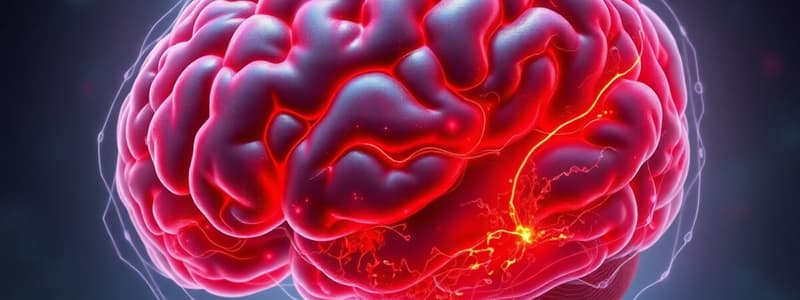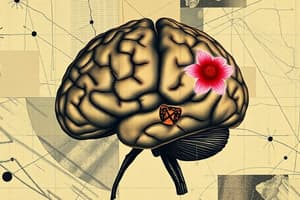Podcast
Questions and Answers
What is the most common type of aneurysm?
What is the most common type of aneurysm?
- Saccular aneurysm (correct)
- Mycotic aneurysm
- Dissecting aneurysm
- Fusiform aneurysm
In which region is the anterior cerebral artery aneurysm most commonly found?
In which region is the anterior cerebral artery aneurysm most commonly found?
- In the basilar artery
- In the middle cerebral artery
- At the bifurcation of internal carotid artery branches (correct)
- In the vertebral artery
What percentage of the population is affected by aneurysms?
What percentage of the population is affected by aneurysms?
- 1% (correct)
- 10%
- 5%
- 0.5%
What is the critical time frame for performing surgery on an aneurysm to prevent irreversible brain damage?
What is the critical time frame for performing surgery on an aneurysm to prevent irreversible brain damage?
Which diagnostic test is NOT commonly used for detecting arteriovenous malformations (AVMs)?
Which diagnostic test is NOT commonly used for detecting arteriovenous malformations (AVMs)?
What condition might occur as a result of a concussion?
What condition might occur as a result of a concussion?
What type of hematoma results from the rupture of a meningeal artery?
What type of hematoma results from the rupture of a meningeal artery?
Which type of brain injury is characterized by hemorrhage of superficial brain parenchyma?
Which type of brain injury is characterized by hemorrhage of superficial brain parenchyma?
What is a common cause of arteriovenous malformations (AVMs) in the brain?
What is a common cause of arteriovenous malformations (AVMs) in the brain?
What percentage of head trauma survivors are left permanently disabled?
What percentage of head trauma survivors are left permanently disabled?
What condition is indicated by the displacement of cerebellar tonsils through the foramen magnum?
What condition is indicated by the displacement of cerebellar tonsils through the foramen magnum?
Which type of hydrocephalus is characterized by obstruction primarily producing cerebrospinal fluid accumulation inside?
Which type of hydrocephalus is characterized by obstruction primarily producing cerebrospinal fluid accumulation inside?
What is the term for areas of the brain that receive dual blood supply from two arteries?
What is the term for areas of the brain that receive dual blood supply from two arteries?
What is the most common arterial distribution site for ischemic infarction?
What is the most common arterial distribution site for ischemic infarction?
What diagnostic test is commonly used for assessing hydrocephalus?
What diagnostic test is commonly used for assessing hydrocephalus?
What is an important predisposing factor for cerebrovascular accidents?
What is an important predisposing factor for cerebrovascular accidents?
In which age group is ischemic infarction most commonly seen?
In which age group is ischemic infarction most commonly seen?
During a hypertensive crisis, where is hemorrhage most likely to occur?
During a hypertensive crisis, where is hemorrhage most likely to occur?
What is a characteristic of non-communicating hydrocephalus?
What is a characteristic of non-communicating hydrocephalus?
What percentage of cardiac output does the brain typically receive?
What percentage of cardiac output does the brain typically receive?
Which type of edema is characterized by increased intracellular fluid due to cell injury?
Which type of edema is characterized by increased intracellular fluid due to cell injury?
What is the primary consequence of vasogenic edema?
What is the primary consequence of vasogenic edema?
Which type of edema is specifically associated with hydrocephalus?
Which type of edema is specifically associated with hydrocephalus?
What anatomical structure is associated with subfalcine herniation?
What anatomical structure is associated with subfalcine herniation?
What are the visual symptoms associated with transtentorial herniation?
What are the visual symptoms associated with transtentorial herniation?
What is a common cause of cytotoxic edema?
What is a common cause of cytotoxic edema?
Which structure is compressed during transtentorial herniation that affects ocular movement?
Which structure is compressed during transtentorial herniation that affects ocular movement?
What is a significant side effect of unregulated diabetes related to edema?
What is a significant side effect of unregulated diabetes related to edema?
What happens to the pupil on the same side of a lesion during transtentorial herniation?
What happens to the pupil on the same side of a lesion during transtentorial herniation?
Which type of brain edema can result from treatment strategies like hemodialysis?
Which type of brain edema can result from treatment strategies like hemodialysis?
Flashcards
Vasogenic Edema
Vasogenic Edema
Brain swelling caused by increased blood vessel permeability.
Interstitial Edema
Interstitial Edema
Brain swelling due to cerebrospinal fluid (CSF) buildup in the brain tissue.
Cytotoxic Edema
Cytotoxic Edema
Brain swelling caused by cellular injury, leading to increased intracellular fluid.
Types of Brain Edema
Types of Brain Edema
Signup and view all the flashcards
Subfalcine Herniation
Subfalcine Herniation
Signup and view all the flashcards
Transtentorial Herniation
Transtentorial Herniation
Signup and view all the flashcards
Pupil Dilation (Transtentorial)
Pupil Dilation (Transtentorial)
Signup and view all the flashcards
Homonymous Hemianopsia
Homonymous Hemianopsia
Signup and view all the flashcards
Brain Herniation
Brain Herniation
Signup and view all the flashcards
Space-occupying Lesions
Space-occupying Lesions
Signup and view all the flashcards
Tonsillar Herniation
Tonsillar Herniation
Signup and view all the flashcards
Hydrocephalus
Hydrocephalus
Signup and view all the flashcards
Communicating Hydrocephalus
Communicating Hydrocephalus
Signup and view all the flashcards
Non-Communicating Hydrocephalus
Non-Communicating Hydrocephalus
Signup and view all the flashcards
Watershed Zone
Watershed Zone
Signup and view all the flashcards
Cerebrovascular Disorder
Cerebrovascular Disorder
Signup and view all the flashcards
Infarction
Infarction
Signup and view all the flashcards
Hemorrhage
Hemorrhage
Signup and view all the flashcards
HTN Crisis
HTN Crisis
Signup and view all the flashcards
Diagnostic Tests: Brain Issues
Diagnostic Tests: Brain Issues
Signup and view all the flashcards
What is an aneurysm?
What is an aneurysm?
Signup and view all the flashcards
Where do aneurysms commonly occur?
Where do aneurysms commonly occur?
Signup and view all the flashcards
What is the most common kind of aneurysm?
What is the most common kind of aneurysm?
Signup and view all the flashcards
What is an arteriovenous malformation (AVM)?
What is an arteriovenous malformation (AVM)?
Signup and view all the flashcards
How can AVMs lead to problems?
How can AVMs lead to problems?
Signup and view all the flashcards
What are the types of traumatic brain injury?
What are the types of traumatic brain injury?
Signup and view all the flashcards
What is a concussion?
What is a concussion?
Signup and view all the flashcards
What is a contusion?
What is a contusion?
Signup and view all the flashcards
What is Coup injury?
What is Coup injury?
Signup and view all the flashcards
What is Countercoup injury?
What is Countercoup injury?
Signup and view all the flashcards
Study Notes
Edema
- Extracellular Edema:
- Vasogenic: Disruption of the blood-brain barrier (BBB), increasing permeability of blood vessels, common in white matter.
- Interstitial: Transependymal flow of cerebrospinal fluid (CSF) causing hydrocephalus and fluid accumulation in the ventricles.
- Intracellular Edema:
- Cytotoxic: Increased intracellular fluid secondary to cell injury, increasing osmotic pressure.
- Vasogenic brain edema: Extracellular edema due to increased permeability of brain capillaries (BBB breakdown), mainly in white matter.
- Cytotoxic (cellular) brain edema: Intracellular edema due to osmotic imbalance between the cell and the extracellular fluid, mainly in gray matter.
- Interstitial (hydrocephalic) brain edema: Extracellular edema in periventricular white matter due to transependymal flow of CSF in hydrocephalus.
- Cytotoxic: Increased intracellular fluid secondary to cell injury, increasing osmotic pressure.
Principal Types of Brain Edema
- Cytotoxic edema → Infarction, trauma
- Vasogenic edema → Brain tumor
- Interstitial edema → Hydrocephalus
- Osmotic edema → Hemodialysis
Etiology of Brain Edema
- Space occupying lesions
- Malignancies/tumors
- Hydrocephaly
- Post-traumatic (cytotoxic edema)
- Metabolic disorders (hyperglycemia - common in uncontrolled diabetes)
Herniation
- Anatomic Factors: Rigidness of cranial vault and dural reflections (dural sinuses and dural folds).
- Types:
- Subfalcine herniation
- Transtentorial herniation
- Tonsillar herniation
- Subfalcine: Herniation of Cingulate gyrus under the Falx cerebri. Anterior gyrus regulates motivation, attention, and behavior; posterior gyrus regulates learning and memory.
- Subdural hematoma: Decrease the occupying mass (drain the blood) or secondary to a tumor (resect or not; depending on type)
Transtentorial Herniation
- Compression: Temporal lobe is compressed against the free margin tentorium cerebri, affecting the 3rd cranial nerve.
- Symptoms: Pupil dilation, impaired ocular movement (ipsilateral); compression of the posterior cerebral artery resulting in ischemic injury to the visual cortex.
- Finding: Homonymous hemianopsia with macular sparing.
- Down and Out: Unopposed superior oblique and lateral rectus muscles lead to down and out gaze with mydriasis. Patient loses accommodation resulting in blurry vision.
- Contralateral: Compression in posterior cerebral artery leads to contralateral homonymous hemianopsia with macular sparing
Tonsillar Herniation
- Compression: Displacement of cerebellar tonsils through the foramen magnum resulting in the compression of the brain stem.
Diagnostic Tests for Hydrocephalus
- CT Scan
- MRI
- Surgical drainage
- Diuretics (Mannitol (1.25g/kg IV over 30-60 minutes, may repeat q 6 to 8hrs)
Hydrocephalus
- Increased production or accumulation of cerebrospinal fluid (CSF).
- Communicating: Obstruction mainly produces CSF and accumulation inside.
- Non-communicating: Obstruction in the passage of CSF within the ventricular system.
Cerebrovascular Disorders
-
Generalized reduction in blood flow leading to hypoxic ischemic injury in watershed areas (dual supply from two arteries).
- Watershed zones: Regions of brain receiving dual blood supply branches of two major arteries.
- Major arteries: MCA, PCA, ACA
Vascular Disorders
- Infarction (80%): Local vascular occlusion (may result in hemorrhages within the parenchyma or subarachnoid space). More common in males, during or after age 70.
- Predisposing factors:
- Arterial hypertension (HTN)
- Diabetes Mellitus (DM)
- Atherosclerosis
- Smoking
Stroke and Transient Ischemic Attack (TIA)
-
Ischemic (80%) most common cause, characterized by a blood clot stopping blood flow to a brain area.
-
Hemorrhagic (20%) characterized by weakened or diseased blood vessels rupturing, causing blood leakage into brain tissue.
-
Stroke Symptoms: lasting less than 1hr termed TIA.
-
TIA Recurrence: 35%.
-
Risk Factors: Age, family history, alcohol use, male sex, hypertension, cigarette smoking, hypercholesterolemia, diabetes, use of certain drugs (cocaine, amphetamines)
Intracranial Hemorrhage (ICH)
-
Complications:
- Sleep disorders
- Confusion
- Depression
- Incontinence (urinary/fecal)
- Pneumonia
- Swallowing dysfunction, leading to dehydration/malnutrition
- Immobility (thromboembolic disease, pressure ulcers, contractures)
- Impaired ADLs, higher brain functions, memory, and verbal communication.
-
Evaluation and Diagnosis: Stroke suspected with sudden neurologic deficits, severe headache, unexplained coma, or sudden impairment of consciousness, require immediate neuroimaging to differentiate hemorrhagic from ischemic stroke and detect signs of increased intracranial pressure.
Treatment for Stroke
- Stabilization: Comatose/non-responsive patients (GCS ≤ 8) require airway support.
- Increased intracranial pressure (ICP): Monitor and measure; reduce cerebral edema.
- Supportive care: Correct coexisting abnormalities (fever, hypoxia, dehydration, hypoglycemia, hypertension)
- Pharmacological: Thrombolytic agents (eg, streptokinase), anticoagulants (e.g., aspirin, Plavix), antihypertensives.
Hemorrhages
- Parenchymal (non-traumatic): Common in 50-60-year-olds. Hypertension is a major cause (>/=50%).
- Causes: congenital disorders, trauma,
Aneurysms
- Saccular/dilations: Congenital defect in the media of arteries at points of bifurcation, affecting vessels composing the Circle of Willis (80%).
- Common location: Bifurcation of internal carotid artery branches (ACA).
- More common in women before age 50.
- Critical size for intervention: 4-6mm.
- Treatment: Surgical clipping within 6 minutes of aneurysm detected to prevent irreversible brain damage.
Arteriovenous Malformation (AVM)
- Congenital vascular abnormalities in the brain (cerebral hemispheres, middle cerebral artery).
Trauma (Epidural/Subdural Hematoma)
-
70% of head trauma survivors are permanently disabled.
- Epidural: Rupture of meningeal artery.
- Subdural: Disruption of bridging veins.
Traumatic Parenchymal Injuries
- Concussion: Transient loss of consciousness with paralysis/seizures, followed by complete recovery.
- Contusion: Hemorrhage of superficial brain parenchyma at the impact site.
- Coup: Changes immediately under the impact site.
- Countercoup: Changes at the opposite, distant impact point.
Studying That Suits You
Use AI to generate personalized quizzes and flashcards to suit your learning preferences.



